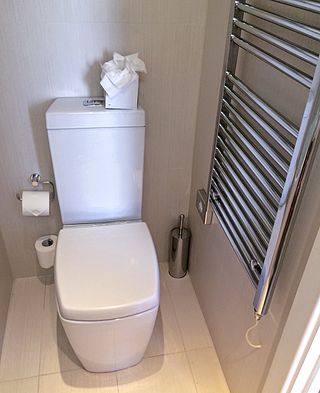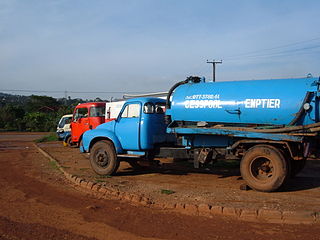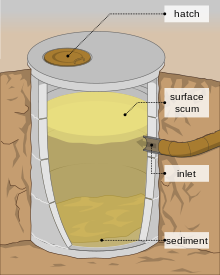
Sewerage is the infrastructure that conveys sewage or surface runoff using sewers. It encompasses components such as receiving drains, manholes, pumping stations, storm overflows, and screening chambers of the combined sewer or sanitary sewer. Sewerage ends at the entry to a sewage treatment plant or at the point of discharge into the environment. It is the system of pipes, chambers, manholes, etc. that conveys the sewage or storm water.

A septic tank is an underground chamber made of concrete, fiberglass, or plastic through which domestic wastewater (sewage) flows for basic sewage treatment. Settling and anaerobic digestion processes reduce solids and organics, but the treatment efficiency is only moderate. Septic tank systems are a type of simple onsite sewage facility. They can be used in areas that are not connected to a sewerage system, such as rural areas. The treated liquid effluent is commonly disposed in a septic drain field, which provides further treatment. Nonetheless, groundwater pollution may occur and can be a problem.

A composting toilet is a type of dry toilet that treats human waste by a biological process called composting. This process leads to the decomposition of organic matter and turns human waste into compost-like material. Composting is carried out by microorganisms under controlled aerobic conditions. Most composting toilets use no water for flushing and are therefore called "dry toilets".

Night soil is a historically used euphemism for human excreta collected from cesspools, privies, pail closets, pit latrines, privy middens, septic tanks, etc. This material was removed from the immediate area, usually at night, by workers employed in this trade. Sometimes it could be transported out of towns and sold on as a fertilizer.
Human waste refers to the waste products of the human digestive system, menses, and human metabolism including urine and faeces. As part of a sanitation system that is in place, human waste is collected, transported, treated and disposed of or reused by one method or another, depending on the type of toilet being used, ability by the users to pay for services and other factors. Faecal sludge management is used to deal with fecal matter collected in on-site sanitation systems such as pit latrines and septic tanks.

A pit latrine, also known as pit toilet, is a type of toilet that collects human waste in a hole in the ground. Urine and feces enter the pit through a drop hole in the floor, which might be connected to a toilet seat or squatting pan for user comfort. Pit latrines can be built to function without water or they can have a water seal. When properly built and maintained, pit latrines can decrease the spread of disease by reducing the amount of human feces in the environment from open defecation. This decreases the transfer of pathogens between feces and food by flies. These pathogens are major causes of infectious diarrhea and intestinal worm infections. Infectious diarrhea resulted in about 700,000 deaths in children under five years old in 2011 and 250 million lost school days. Pit latrines are a low-cost method of separating feces from people.

A bucket toilet is a basic form of a dry toilet whereby a bucket (pail) is used to collect excreta. Usually, feces and urine are collected together in the same bucket, leading to odor issues. The bucket may be situated inside a dwelling, or in a nearby small structure.
Manual scavenging is a term used mainly in India for "manually cleaning, carrying, disposing of, or otherwise handling, human excreta in an insanitary latrine or in an open drain or sewer or in a septic tank or a pit". Manual scavengers usually use hand tools such as buckets, brooms and shovels. The workers have to move the excreta, using brooms and tin plates, into baskets, which they carry to disposal locations sometimes several kilometers away. The practice of employing human labour for cleaning of sewers and septic tanks is also prevalent in Bangladesh and Pakistan. These sanitation workers, called "manual scavengers", rarely have any personal protective equipment. The work is regarded as a dehumanizing practice.

Gong farmer was a term that entered use in Tudor England to describe someone who dug out and removed human excrement from privies and cesspits. The word "gong" was used for both a privy and its contents. As the work was considered unclean and off-putting to the public, gong farmers were only allowed to work at night, hence they were sometimes known as nightmen. The waste they collected, known as night soil, had to be taken outside the city or town boundary or to official dumps for disposal.

Sustainable sanitation is a sanitation system designed to meet certain criteria and to work well over the long-term. Sustainable sanitation systems consider the entire "sanitation value chain", from the experience of the user, excreta and wastewater collection methods, transportation or conveyance of waste, treatment, and reuse or disposal. The Sustainable Sanitation Alliance (SuSanA) includes five features in its definition of "sustainable sanitation": Systems need to be economically and socially acceptable, technically and institutionally appropriate and protect the environment and natural resources.
A mound system is an engineered drain field for treating wastewater in places with limited access to multi-stage wastewater treatment systems. Mound systems are an alternative to the traditional rural septic system drain field. They are used in areas where septic systems are prone to failure from extremely permeable or impermeable soils, soil with the shallow cover over porous bedrock, and terrain that features a high water table.

A toilet is a piece of sanitary hardware that collects human urine and feces, and sometimes toilet paper, usually for disposal. Flush toilets use water, while dry or non-flush toilets do not. They can be designed for a sitting position popular in Europe and North America with a toilet seat, with additional considerations for those with disabilities, or for a squatting posture more popular in Asia, known as a squat toilet. In urban areas, flush toilets are usually connected to a sewer system; in isolated areas, to a septic tank. The waste is known as blackwater and the combined effluent, including other sources, is sewage. Dry toilets are connected to a pit, removable container, composting chamber, or other storage and treatment device, including urine diversion with a urine-diverting toilet.

A sanitation worker is a person responsible for cleaning, maintaining, operating, or emptying the equipment or technology at any step of the sanitation chain. This is the definition used in the narrower sense within the WASH sector. More broadly speaking, sanitation workers may also be involved in cleaning streets, parks, public spaces, sewers, stormwater drains, and public toilets. Another definition is: "The moment an individual’s waste is outsourced to another, it becomes sanitation work." Some organizations use the term specifically for municipal solid waste collectors, whereas others exclude the workers involved in management of solid waste sector from its definition.

A vacuum truck, vacuum tanker, vactor truck, vactor, vac-con truck, vac-con is a tank truck that has a pump and a tank. The pump is designed to pneumatically suck liquids, sludges, slurries, or the like from a location into the tank of the truck. The objective is to enable transport of the liquid material via road to another location. Vacuum trucks transport the collected material to a treatment or disposal site, for example a sewage treatment plant.

Effluent sewer systems, also called septic tank effluent gravity (STEG), solids-free sewer (SFS), or septic tank effluent drainage (STED) systems, have septic tanks that collect sewage from residences and businesses, and the liquid fraction of sewage that comes out of the tank is conveyed to a downstream receiving body such as either a centralized sewage treatment plant or a distributed treatment system for further treatment or disposal away from the community generating the sewage. Most of the solids are removed by the interceptor tanks, so the treatment plant can be much smaller than a typical plant and any pumping for the supernatant can be simpler without grinders.

The history of water supply and sanitation is one of a logistical challenge to provide clean water and sanitation systems since the dawn of civilization. Where water resources, infrastructure or sanitation systems were insufficient, diseases spread and people fell sick or died prematurely.

The ancient Indus Valley Civilization in the Indian subcontinent was prominent in infrastructure, hydraulic engineering, and had many water supply and sanitation devices that are the first known examples of their kind.

A urine-diverting dry toilet (UDDT) is a type of dry toilet with urine diversion that can be used to provide safe, affordable sanitation in a variety of contexts worldwide. The separate collection of feces and urine without any flush water has many advantages, such as odor-free operation and pathogen reduction by drying. While dried feces and urine harvested from UDDTs can be and routinely are used in agriculture, many UDDT installations do not apply any sort of recovery scheme. The UDDT is an example of a technology that can be used to achieve a sustainable sanitation system. This dry excreta management system is an alternative to pit latrines and flush toilets, especially where water is scarce, a connection to a sewer system and centralized wastewater treatment plant is not feasible or desired, fertilizer and soil conditioner are needed for agriculture, or groundwater pollution should be minimized.

Fecal sludge management (FSM) is the storage, collection, transport, treatment and safe end use or disposal of fecal sludge. Together, the collection, transport, treatment and end use of fecal sludge constitute the "value chain" or "service chain" of fecal sludge management. Fecal sludge is defined very broadly as what accumulates in onsite sanitation systems and specifically is not transported through a sewer. It is composed of human excreta, but also anything else that may go into an onsite containment technology, such as flushwater, cleansing materials, menstrual hygiene products, grey water, and solid waste. Fecal sludge that is removed from septic tanks is called septage.
A bayakou is a sanitation worker who works to empty the fecal sludge out of pit latrines in Haiti, especially in larger cities, such as Port-au-Prince. The word bayakou comes from Haitian Creole. Bayakou are subjected to social stigma for their work in manually emptying septic tanks and pit latrines.

















